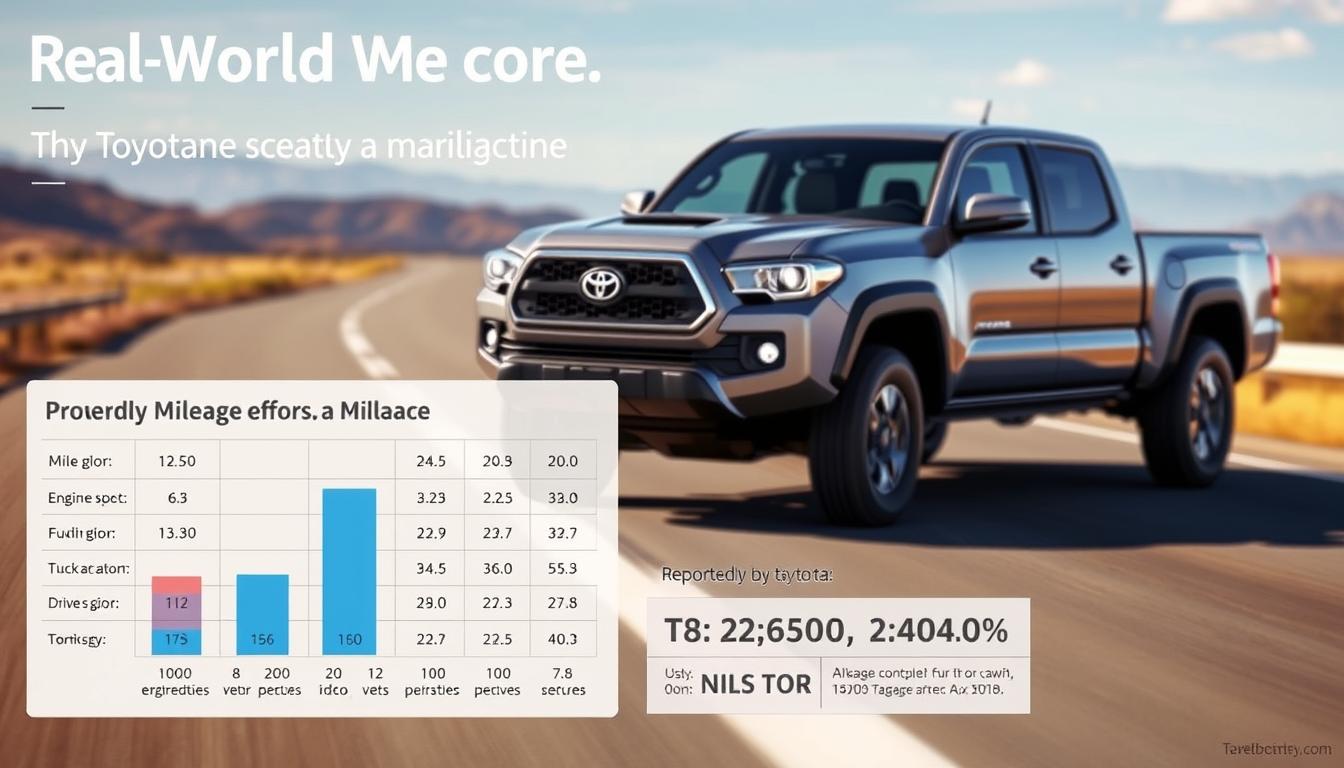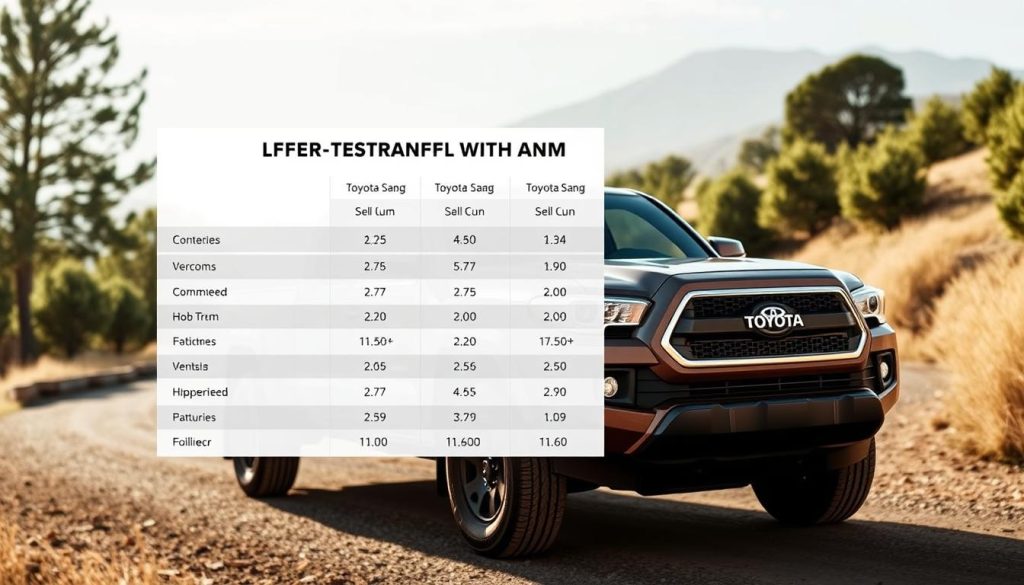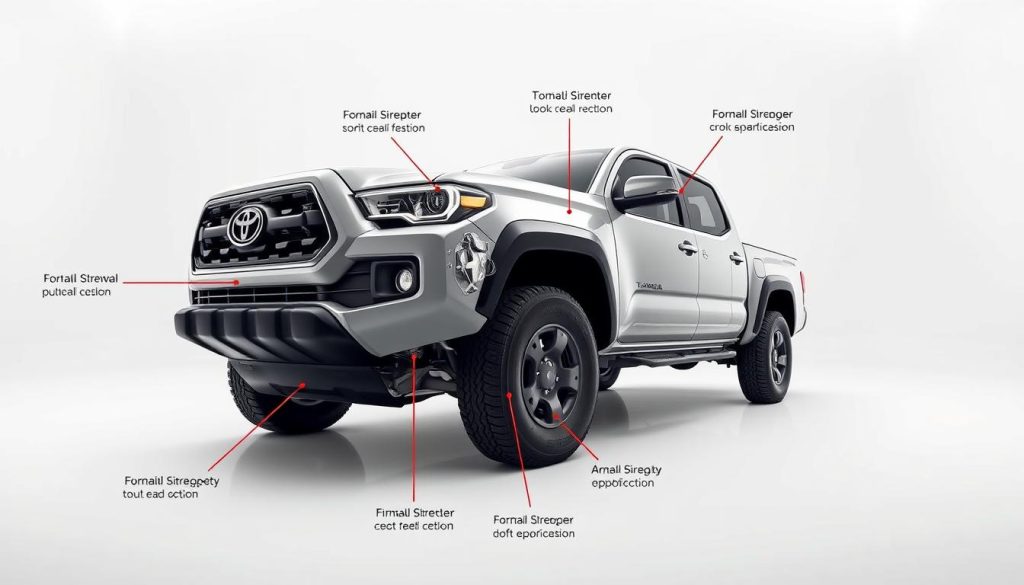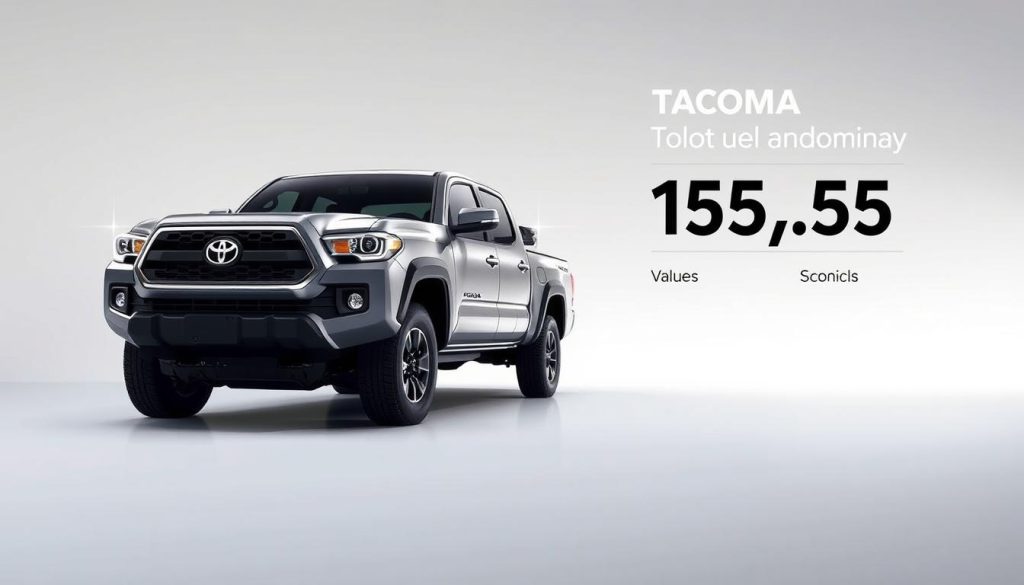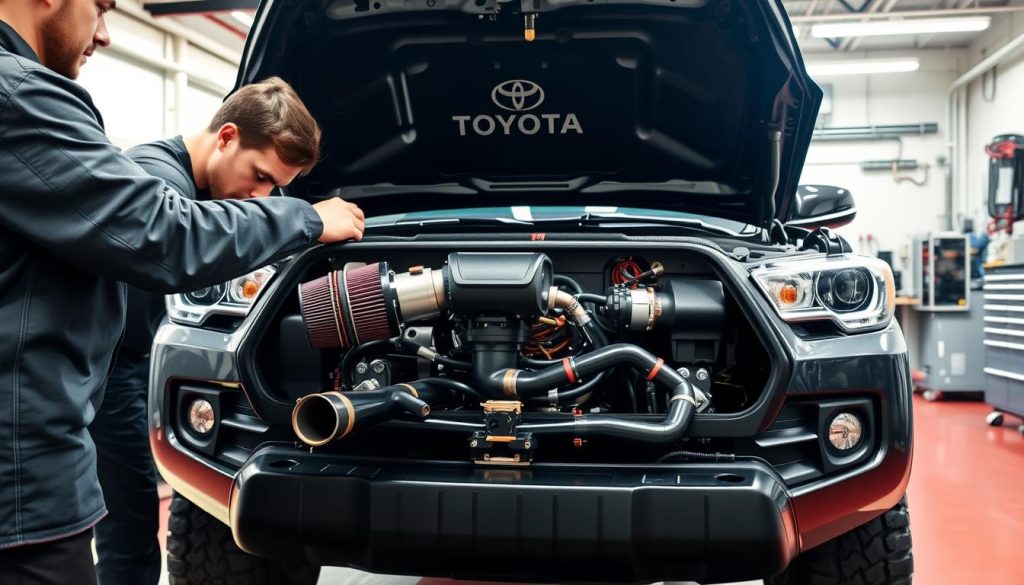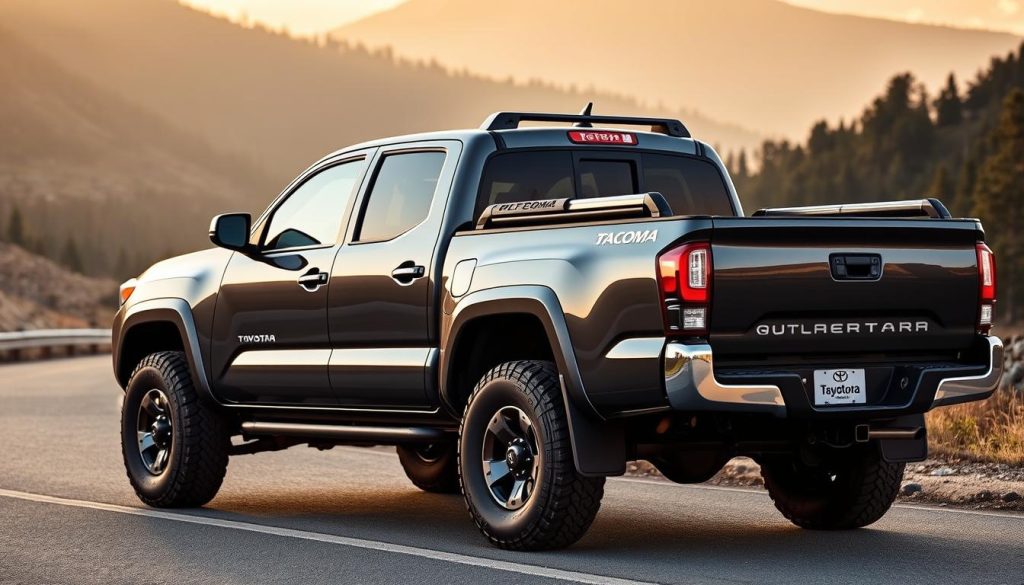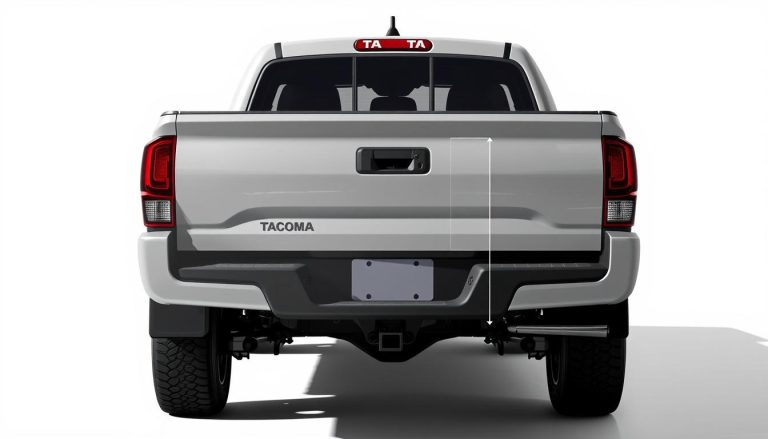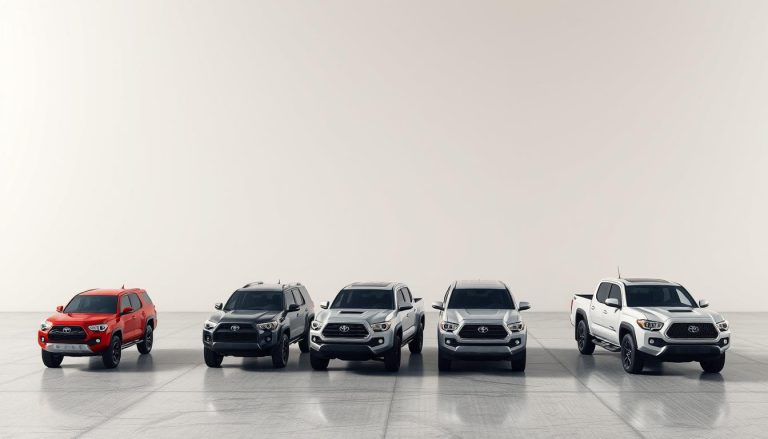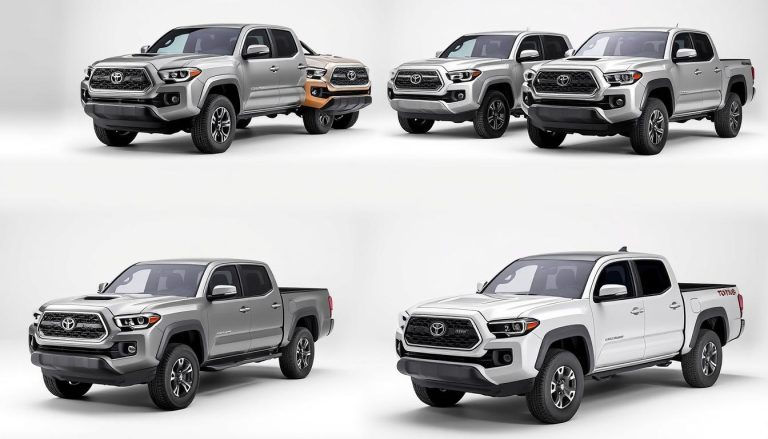Real-World Tacoma Fuel Efficiency – What Owners Report
Forget the EPA sticker numbers on your truck’s window. Real Toyota Tacoma MPG tells a different story than what the manufacturer says. Real drivers face hills, traffic, and weather that labs can’t replicate.
The numbers don’t lie when it comes to authentic performance data. Over 12,336 Toyota pickup owners have tracked their mileage. They’ve driven 300.3 million miles. This huge database shows what your truck really does at the pump.
These aren’t just guesses or marketing tricks. Tacoma fuel efficiency real-world tracking shows real results. It’s based on everyday drives, weekend trips, and work hauls. Your truck’s model year, engine, and how you drive all affect your fuel costs.
Knowing your truck’s real fuel use helps you plan better and drive more efficiently. Let’s look at what thousands of owners say about their truck’s fuel economy. We’ll also find tips to help you get better mileage.
Key Takeaways
- Over 12,336 Toyota trucks provided authentic mileage data across 300+ million miles
- Owner-reported numbers often differ significantly from EPA estimates
- Driving conditions and habits greatly impact actual consumption rates
- Different model years show varying performance patterns
- Real tracking data helps set realistic expectations for your truck
Understanding Your Toyota Tacoma’s Baseline Fuel Economy
Knowing your Toyota Tacoma’s baseline fuel economy is key to improving fuel efficiency. It shows how your truck compares to others and meets manufacturer standards.
Every Tacoma model performs differently due to various factors. Your truck’s fuel economy is shaped by its specific setup.
Real-world data shows big differences in Tacoma fuel economy. The 2025 models get an average of 20.1 MPG. Older models get lower numbers. These numbers mean real savings at the pump.
Your baseline should consider important factors:
- Model year and generation – Newer Tacomas are more fuel-efficient
- Engine type – Four-cylinder and V6 engines use fuel differently
- Transmission system – Manual or automatic affects fuel use
- Drive configuration – Two-wheel drive or four-wheel drive changes efficiency
- Current vehicle condition – Maintenance affects performance
Getting an accurate baseline means knowing your truck’s current state. Don’t compare your 2010 Tacoma to a 2024 model – each has its own strengths and weaknesses.
Tracking your truck’s performance for three full tanks is a good start. This gives you reliable data for different driving and seasons. Consistency in measurement leads to accurate results.
Knowing where you start helps set realistic goals for improvement. A well-kept Tacoma can be optimized more than one that needs repairs.
This knowledge guides all future efforts to boost your Toyota Tacoma’s fuel efficiency. Whether it’s through modifications, driving habits, or maintenance, your baseline is the key to measuring success.
How EPA Ratings Compare to Owner-Reported Toyota Tacoma MPG
EPA ratings and real-world MPG show a big difference in Tacoma performance. EPA tests are done in a lab, not in real driving. Things like traffic and weather affect how much gas you use.
EPA tests use special machines to simulate driving. But they can’t handle hills, headwinds, or city traffic. Knowing this helps you understand what to expect with your Tacoma’s fuel use.
Many Tacoma owners share their real MPG. This data is more useful than lab tests for planning your gas budget. The real-world toyota tacoma mpg data reflects your actual driving.
2024 Tacoma EPA vs Real-World Numbers
2024 Tacoma owners report an average of 19.1 MPG. This comes from 3,308 fuel-ups over 787,682 miles. The EPA rates it higher, but real driving shows a different picture.
Weather, terrain, and how you drive affect MPG. City drivers usually get lower numbers than those on the highway. The 2024 Tacoma performs well in different driving situations, helping you plan your fuel costs.
I track every fill-up in my 2024 Tacoma, and I’m consistently hitting 19.2 MPG in mixed driving. It’s lower than EPA estimates, but I know what to expect now.
Early 2025 model data shows a big jump, with owners reporting 20.1 MPG average. This is a full mile per gallon better than the 2024 model. Toyota’s updates seem to make a big difference.
Historical Model Year Comparisons
Looking at past models shows how tacoma epa ratings have changed. Each new generation brings new tech and design. These changes affect both EPA ratings and real-world MPG.
Second-generation Tacomas (2005-2015) often did better on the highway than EPA said. Third-generation models (2016-present) are more consistent. This makes it easier to plan your fuel budget.
The gap between EPA and real-world MPG has gotten smaller over time. Newer tests better match real driving. But, your results can vary based on how you drive, maintenance, and local conditions.
Understanding these patterns helps you compare your Tacoma to others. You can see if your MPG is normal or if there’s a problem.
Step 1: Calculate Your Tacoma’s Actual Miles Per Gallon
Tracking your Toyota Tacoma gas mileage starts with a good system. You need to know your truck’s fuel use to improve it. Without the right data, you can’t see how well you’re doing.
There’s a big database of fuel-up records from many owners. It shows how important it is to keep track regularly. Many Tacoma owners use both manual and digital methods to check their MPG.
Manual Calculation Method
Using your hands ensures your data is correct. Start by writing down your odometer reading when you fill up. Also, reset your trip meter to zero.
At your next fill-up, write down the new odometer reading and gallons. Then, subtract your starting mileage from the ending to find total miles. Divide miles by gallons to find your Toyota Tacoma gas mileage.
Keep a logbook in your glove compartment. Write down the date, odometer reading, gallons, and cost. This helps you see how your truck does in different situations.
Digital Tracking Tools and Apps
Smartphone apps can make tracking easier. Apps like Fuelly, GasBuddy, and Road Trip MPG store your data online. They give you detailed reports automatically.
These apps also offer features like maintenance reminders and cost tracking. Some even track your driving routes. This helps you see what affects your fuel use.
Digital tools help you keep records over time. They can show averages, trends, and how you compare to others. The most important thing is to pick a method you’ll stick with.
| Tracking Method | Accuracy Level | Time Required | Additional Features |
|---|---|---|---|
| Manual Logbook | High | 2-3 minutes per fill-up | Complete data control |
| Smartphone Apps | High | 1-2 minutes per fill-up | Automatic calculations, reports |
| Vehicle Computer | Moderate | Instant reading | Real-time feedback |
| Hybrid Method | Very High | 3-4 minutes per fill-up | Cross-verification, backup data |
Choose manual logs, digital tools, or a mix that works for you. Regular tracking shows patterns to improve your Tacoma’s fuel use. Pick what fits your lifestyle best.
Step 2: Identify Factors Specific to Your Tacoma Configuration
The engine, transmission, and drivetrain of your Tacoma affect its fuel use. Real-world data shows big differences in tacoma truck mpg based on these factors. Knowing these differences helps you understand what to expect from your truck.
Your Tacoma’s original setup is the base for any fuel economy gains. Each part affects how well your truck turns gasoline into motion. These parts work together to shape your truck’s fuel use.
Engine Type and Transmission Differences
The engine in your truck is key to its tacoma truck mpg performance. Four-cylinder engines usually use less fuel than V6 engines, which is good for long drives. This is because they need less fuel when driving lightly.
Manual transmissions can offer better fuel economy if you drive well. But, modern automatics have caught up with them. They use advanced tech and more gears.
Transmission gear ratios matter for your engine’s performance at different speeds. More gears mean the engine stays in its best range more often. This leads to better tacoma truck mpg in various driving situations.
Drive System Impact on Fuel Economy
Choosing between 2WD and 4WD affects fuel use. 4WD models usually use more fuel because of extra parts and weight. These parts add friction and need more energy to move.
Part-time 4WD lets you switch between 2WD and 4WD as needed. Driving in 2WD saves fuel. Full-time AWD provides constant traction but uses more fuel all the time.
Weight also plays a role in tacoma truck mpg. Heavier trucks need more energy to move. 4WD systems add 200-300 pounds compared to 2WD models.
| Configuration | Engine | Transmission | EPA City MPG | EPA Highway MPG |
|---|---|---|---|---|
| 2WD Regular Cab | 2.7L 4-Cylinder | 6-Speed Manual | 20 | 23 |
| 2WD Double Cab | 3.5L V6 | 8-Speed Automatic | 20 | 24 |
| 4WD Double Cab | 3.5L V6 | 8-Speed Automatic | 19 | 22 |
| 4WD CrewMax | 3.5L V6 | 8-Speed Automatic | 18 | 22 |
Knowing your truck’s setup helps you find ways to improve tacoma truck mpg. Improvements come from working with your truck’s parts, not against them.
Real-World Toyota Tacoma MPG Reports by Generation
Each Toyota Tacoma generation has its own fuel economy. This affects how you drive every day. Knowing these differences helps you understand what to expect and how to improve your truck’s performance.
Millions of miles driven by real owners show interesting patterns. Toyota Tacoma real-world MPG changes a lot. This is because of the tech and design of each generation.
“The beauty of owning a Tacoma is knowing exactly what to expect from your fuel economy, regardless of which generation you drive.”
Third Generation (2016-Present) Owner Experiences
Today’s Tacomas are known for their consistent fuel efficiency. Tracking data from over 25.3 million miles shows an average of 18.2 MPG.
The 2017 model is a standout in this generation. Owners say it keeps a steady fuel economy, no matter where they drive.
Thanks to better engine tech and design, these trucks use fuel predictably. Most owners see their mileage match their expectations.
Second Generation (2005-2015) Long-Term Results
Second-generation Tacomas are known for their reliability and steady fuel economy. They average between 17.1 and 17.6 MPG over their lifespan.
Even with high mileage, these trucks keep their fuel efficiency. Many owners report no drop in MPG after 200,000 miles.
Their strong build means they keep performing well, even after years of use.
First Generation Legacy Performance
First-generation Tacomas from the late 1990s are known for their great fuel efficiency. They often got between 18.3 and 20.1 MPG in real driving.
The 1997 and 2000 models are the best in fuel economy. Their light weight and simple engines made them very efficient for their time.
Many enthusiasts choose these older models for their better MPG. Even today, well-kept first-generation Tacomas can beat newer models in fuel efficiency.
Step 3: Assess Your Driving Environment and Patterns
Assessing your driving environment can boost your tacoma fuel efficiency real-world performance. Your daily routes and habits show why your gas mileage changes. This step helps find small changes for big improvements.
Most Tacoma owners don’t know how much their environment affects fuel use. Traffic patterns, road types, and driving schedules all impact efficiency. By analyzing these, you can plan better routes and driving strategies.
Urban vs Rural Driving Analysis
Urban driving is tough for tacoma fuel efficiency real-world optimization. Stop-and-go traffic makes your engine work harder. Traffic lights, congestion, and braking cycles can cut your MPG by 20-30% compared to highways.
City driving means more idling at red lights and in traffic. Your Tacoma burns fuel while stationary, getting zero MPG. Short city blocks with frequent stops prevent your engine from reaching its most efficient zones.
Rural and highway driving offer better fuel economy chances. Sustained speeds let your transmission stay in high gears for better efficiency. Less braking means more energy for forward motion.
Highway driving improves tacoma fuel efficiency real-world by 25-40% over city driving. Your engine works best between 45-65 mph on flat roads. Wind resistance is the main factor, not constant acceleration and deceleration.
Commute Distance and Frequency Impact
Short commutes under five miles hurt your fuel economy. Your Tacoma’s engine needs time to warm up for maximum efficiency. Cold engines use richer fuel mixtures and operate less efficiently until warmed up completely.
Winter conditions worsen short trip penalties. Cold weather increases warm-up time and reduces fuel efficiency. Your tacoma fuel efficiency real-world performance can drop 15-25% in winter, on short trips.
Longer commutes allow your engine to warm up and stay at ideal temperatures. Once warmed up, your Tacoma delivers its best fuel economy. Trips over 10 miles typically show marked improvement in average MPG compared to shorter journeys.
Commute frequency also matters for fuel planning and optimization strategies. Daily drivers have more chances to implement efficiency techniques and see results. Occasional weekend drivers may not notice small improvements as readily but can also benefit from route and driving pattern analysis.
Understanding your specific driving environment helps prioritize which efficiency strategies will deliver the biggest impact. Urban drivers should focus on traffic timing and route optimization, while rural drivers can emphasize speed management and maintenance scheduling for maximum tacoma fuel efficiency real-world gains.
What Owners Report About Highway vs City Tacoma Fuel Economy
Driving on highways shows big differences in Toyota Tacoma MPG compared to city driving. Owners say they get better gas mileage on highways. This is because of steady speeds and less braking.
Real-world data shows highway driving can improve fuel efficiency by 20-30% over city conditions. This is due to less engine load and consistent throttle settings. Understanding these differences helps owners plan their driving strategies effectively.
Highway and city driving are very different, as owner reports show. Highways let the Tacoma’s engine work best. But city driving, with lots of starts and stops, cuts down on efficiency.
Optimal Highway Cruising Speeds
To get the best Toyota Tacoma MPG on highways, knowing the right speed is key. Most owners find their best gas mileage between 60-70 mph. Going over 75 mph can lower efficiency because of more wind resistance.
One owner reported getting 26+ MPG on highway drives at 70 mph. They expect 27-28 MPG at 65 mph with cruise control for long trips. These numbers show what’s possible under the best conditions.
“I consistently get over 26 MPG on highway trips when I keep it around 70 mph. Drop it to 65 with cruise control, and I’m looking at 27-28 MPG easy.”
Cruise control is important for keeping speeds steady. It stops small throttle changes that drivers make. This steady speed helps improve gas mileage.
| Speed Range | Typical MPG | Driving Conditions | Efficiency Rating |
|---|---|---|---|
| 60-65 mph | 27-28 | Cruise control, flat terrain | Excellent |
| 65-70 mph | 25-27 | Steady highway driving | Very Good |
| 70-75 mph | 23-25 | Normal highway speeds | Good |
| 75+ mph | 20-23 | High-speed cruising | Fair |
Stop-and-Go Traffic Strategies
City driving is tough for keeping Toyota Tacoma MPG up. Stop-and-go traffic means lots of starts and stops. This hurts the engine’s efficiency.
Drivers who do well in cities use smooth acceleration techniques. Slowly pressing the gas saves fuel. Also, driving smoothly helps keep momentum.
Knowing when to hit the gas at traffic lights is key. Drivers aim to slow down before lights, so they can coast to a stop. Coasting to red lights saves fuel compared to hard braking.
Turning off the engine when stopped for a while saves fuel. Modern Tacomas can handle frequent starts without problems.
Planning your route can also help. Using apps to find less busy roads can improve gas mileage. Even longer routes might be better if they avoid traffic.
Step 4: Implement Maintenance-Based Fuel Economy Improvements
Keeping your Toyota truck in top shape can boost its Tacoma fuel economy. Regular maintenance makes your engine run better and more efficiently. Many people notice a big difference just by following the recommended maintenance schedule.
Good fuel efficiency starts with regular care. Your Tacoma will thank you for it. Making smart maintenance choices can save you money at the pump.
Critical Maintenance Schedule Items
Changing your oil regularly is key to Tacoma fuel economy. Clean oil means less friction and better engine performance. Most drivers should change their oil every 5,000 to 7,500 miles, depending on how much they drive.
Spark plugs also play a big role. Worn-out plugs can cause your engine to run poorly. It’s important to replace them as recommended by your owner’s manual.
Cleaning your fuel system is another must. It keeps your engine running smoothly. Professional cleaning every 30,000 miles is a good idea for the best results.
- Oil changes every 5,000-7,500 miles
- Spark plug replacement per manufacturer schedule
- Fuel system cleaning every 30,000 miles
- Regular fluid level checks
Air Intake and Exhaust System Care
Clean air filters are essential for Tacoma fuel economy. They ensure your engine gets the air it needs. Check your air filter every 12,000 miles or more often if you drive in dusty areas.
Keeping your exhaust system in good shape is also important. A clogged catalytic converter or damaged pipes can hurt your engine’s performance. This can lead to lower Tacoma fuel economy.
Mass airflow sensors need to be cleaned regularly. A dirty sensor can give your engine the wrong information. This can make your engine work harder and use more fuel.
Tire Selection and Pressure Optimization
Proper tire pressure is a simple way to save fuel. Under-inflated tires make your truck work harder. Check your tire pressure every month and keep it at the recommended level.
The type of tires you choose also affects your Tacoma fuel economy. All-terrain tires are great for off-road adventures but might not be as fuel-efficient as highway tires. Pick tires that fit your driving style.
Regular tire rotations help your tires last longer. Uneven wear can make your truck less efficient. Rotate your tires every 5,000-7,500 miles for the best performance.
- Check tire pressure monthly
- Rotate tires every 5,000-7,500 miles
- Choose appropriate tire type for driving conditions
- Replace tires when tread depth reaches 4/32 inch
Sticking to a maintenance routine can really pay off for your Tacoma fuel economy. These small improvements add up over time. Your wallet will appreciate the extra effort.
Tacoma Fuel Efficiency Real-World Enhancement Techniques
There are practical ways to boost Toyota Tacoma fuel efficiency without losing truck power. These tweaks go beyond regular maintenance. They tackle specific factors that affect real-world performance. Smart tweaks focus on two main areas that impact fuel use during daily driving.
The success of these methods depends on your driving habits and current truck setup. Drivers on highways get the most from aerodynamic tweaks. Those who often carry heavy loads see better results from weight management.
Weight Reduction Strategies
Every extra pound in your Tacoma means more fuel to move it. Weight reduction is a cost-effective way to improve fuel economy. It’s most noticeable in city driving with lots of stops and starts.
Start by removing items from your truck bed that you don’t need right away. Heavy toolboxes, spare parts, and equipment add a lot of weight. Consider using lighter options or storing them elsewhere when not in use.
Reducing weight inside your truck also helps with Toyota Tacoma fuel efficiency. Remove unnecessary floor mats, extra seats in crew cab models when not needed, and heavy aftermarket accessories. Even small weight cuts add up over thousands of miles.
Look at your spare tire setup too. Full-size spares are heavy, and switching to a temporary spare can save 30-50 pounds. But think about your off-road needs and driving habits before making this change.
Aerodynamic Improvements
Wind resistance grows fast with speed, making aerodynamic tweaks key for highway driving. Tonneau covers are the most popular for reducing bed turbulence. Hard covers usually offer better aerodynamic benefits than soft ones.
Air dams and front spoilers direct airflow around and under your Tacoma more efficiently. These work best when paired with other aerodynamic tweaks. The goal is to keep airflow smooth from front to rear.
External accessories like roof racks, light bars, and antennas increase drag and fuel use. Remove them when not needed, or choose low-profile options that reduce wind resistance.
Tailgate position affects aerodynamics more than many think. Driving with the tailgate down doesn’t save fuel as often believed. It actually increases drag compared to driving with the tailgate up.
| Enhancement Type | Typical MPG Improvement | Best Driving Conditions | Implementation Cost |
|---|---|---|---|
| Weight Reduction (100 lbs) | 1-2% improvement | City and mixed driving | $0-50 |
| Tonneau Cover | 2-5% improvement | Highway speeds 55+ mph | $200-800 |
| Air Dam Installation | 1-3% improvement | Highway driving | $100-300 |
| Accessory Removal | 2-4% improvement | All driving conditions | $0 |
The best approach combines several tweaks, not just one. Weight reduction helps in all driving, while aerodynamic tweaks are best on highways. Keep track of your fuel economy before and after each tweak. This helps find the best methods for your driving style.
Step 5: Master Fuel-Efficient Driving Techniques
Smart driving habits can boost your Toyota Tacoma’s gas mileage right away. Drivers who drive wisely can reach the top fuel economy for their model year, all without spending money on upgrades. These habits make your engine work better in different driving situations.
Improving your driving skills is quick and easy. You’ll see better gas numbers on your next fill-up. Many Tacoma owners find they’ve been hurting their fuel efficiency by driving too fast and not smoothly.
Throttle Control and Smooth Acceleration
Using the throttle gently can make a big difference in your Tacoma’s gas use. Driving smoothly keeps your engine in its best working range, avoiding the extra fuel needed for quick starts. This is very helpful for the Tacoma’s engines that don’t have turbochargers.
Think of your accelerator pedal like an egg you don’t want to break. Press it slowly and steadily when starting from a stop. Try to reach your speed without downshifting or running the engine too high.
Experts suggest the “15-second rule” for city driving. Take about 15 seconds to hit 45 mph from a stop. It might feel slow at first, but it really helps your gas mileage without slowing down traffic too much.
Engine Braking and Coasting Methods
Knowing when to slow down helps you use less fuel when you’re not moving. Using engine braking and coasting saves energy. These are great for city driving.
When you see a red light or slow traffic, take your foot off the gas early. Let your Tacoma coast down instead of keeping speed. This cuts down on fuel use and brake wear while keeping a safe distance.
Downhills are perfect for practicing engine braking. Use the manual mode or lower gears to control your speed without brakes. This keeps your engine running well and uses gravity to slow you down.
| Driving Technique | Fuel Economy Impact | Implementation Difficulty | Immediate Results |
|---|---|---|---|
| Gradual Acceleration | 8-12% improvement | Easy | First tank |
| Anticipatory Coasting | 5-8% improvement | Moderate | Within week |
| Engine Braking | 3-6% improvement | Easy | Immediate |
| Steady Highway Speeds | 10-15% improvement | Easy | First highway trip |
Using these techniques together can really improve your Tacoma’s fuel efficiency. Drivers who get good at controlling the throttle and managing speed can hit EPA highway numbers even in city driving. Learning these skills saves you money every time you fill up.
How Tacoma Modifications Impact Real-World Gas Mileage
Every change you make to your Toyota Tacoma affects its fuel economy. The toyota tacoma gas mileage can vary a lot, depending on the accessories and upgrades you add. Knowing how these changes impact your truck helps you make better choices.
Choosing the right modifications can actually make your truck more efficient. But, many popular upgrades can also increase fuel costs. It’s important to understand how each change affects your truck’s aerodynamics, weight, and mechanical efficiency.
Bed Accessories and Fuel Economy
Bed accessories are a common Tacoma modification, but their impact on fuel economy varies. Tonneau covers consistently improve fuel efficiency by reducing drag in the truck bed. Hard covers usually work better than soft ones, with some owners seeing a 1-2 mpg improvement on the highway.
Bed liners and toolboxes have a different effect. They add weight, which directly affects fuel consumption. A heavy-duty bed liner can add 50-100 pounds to your truck’s weight.
Toolboxes and cargo management systems have a bigger impact. Large aluminum toolboxes can add 150-200 pounds and disrupt airflow. The effect depends on how you use your truck and whether the benefits outweigh the fuel cost.
“I installed a hard tonneau cover and removed my heavy toolbox last year. My highway mileage improved from 22 mpg to 24 mpg on my regular commute route.”
Suspension and Tire Upgrade Consequences
Suspension modifications and tire upgrades often focus on capability over fuel efficiency. Lifted suspensions increase drag and change your truck’s center of gravity. This usually reduces toyota tacoma gas mileage by 2-4 mpg, depending on the lift height.
Larger tires also have challenges. They increase rolling resistance, add weight, and change gear ratios. Moving to oversized all-terrain tires can reduce fuel economy by 10-15%.
But, some modifications can offer unexpected benefits. A modest leveling kit might improve aerodynamics compared to the factory angle. High-quality lightweight wheels can also help offset some losses from larger tires.
The main idea is that every modification has trade-offs. Successful Tacoma owners think carefully about their priorities. They choose upgrades that match their driving needs and fuel economy goals. Planning your modifications wisely helps you keep efficiency while getting the look and capability you want.
Step 6: Create a Fuel Efficiency Monitoring System
Monitoring your Tacoma truck’s mpg is key to improving its performance. It’s more than just tracking gas mileage. It shows how your truck does in different situations.
Good fuel tracking uses many data points in one system. This way, you spot patterns that simple numbers can’t show. Successful Tacoma owners keep detailed records to see big improvements.
Your system should track both numbers and context. Numbers are important, but knowing the situation behind them is even more so. Things like weather, traffic, and what you’re doing with your truck matter a lot.
Documentation and Record Keeping
Start by collecting data at every fuel stop. Note the odometer reading, gallons, and cost. Smartphone apps can make this easy.
Also, document the driving conditions for each tank. Keep track of highway vs. city driving, weather, and what you’re carrying. These details help explain why your fuel efficiency changes.
Don’t forget to log maintenance events. Record oil changes, air filter swaps, and tire rotations. Tracking these with fuel economy shows which services help the most.
Keep records of any upgrades or changes to your Tacoma. Note what was changed, when, and the cost. This info is key to seeing how each change affects fuel economy.
Performance Benchmarking
Benchmarking compares your Tacoma to others in big databases. These platforms collect fuel economy data from many vehicles. This helps you see if your truck is doing well or not.
Watch your monthly averages to spot trends in fuel efficiency. Normal changes happen with the seasons, but steady drops might mean you need maintenance. Regular checks help avoid costly repairs.
Set goals based on your truck’s current performance and what similar trucks do. Small improvements can lead to big savings over time. Focus on one area at a time for the best results.
Check your data every quarter to see what works for you. The best insights come from comparing before and after changes. This helps you spend your time and money wisely on upgrades that boost your truck’s mpg.
Troubleshooting Common Tacoma Fuel Economy Issues
Poor fuel economy in Toyota Tacoma trucks often comes from mechanical problems. Owners can find and fix these issues. Knowing the common causes saves time and money.
Fuel economy problems can sneak up on you. Keeping an eye on your toyota tacoma real-world mpg helps catch issues early.
Mechanical Problems Affecting MPG
Several mechanical issues hurt your Tacoma’s fuel efficiency. Oxygen sensors are a common problem. They check exhaust gases and adjust fuel mix.
Dirty or bad oxygen sensors make the engine run wrong. This wastes fuel and lowers efficiency. Tacomas have many oxygen sensors that can fail.
Clogged fuel injectors are another big problem. They spray fuel into cylinders. Dirty injectors mess up the fuel spray.
Spark plugs are key to fuel efficiency. Worn plugs lead to weak ignition. This makes the engine work harder and use more fuel.
The mass airflow sensor measures air and helps with fuel delivery. A dirty or failing sensor gives wrong data. This leads to bad fuel mix and lower efficiency.
| Component | Symptoms | Fuel Economy Impact | Replacement Cost |
|---|---|---|---|
| Oxygen Sensors | Check engine light, rough idle | 15-25% reduction | $150-300 |
| Fuel Injectors | Poor acceleration, engine knock | 10-20% reduction | $200-500 |
| Spark Plugs | Misfiring, hard starting | 5-15% reduction | $50-150 |
| Mass Airflow Sensor | Stalling, hesitation | 10-30% reduction | $100-250 |
Diagnostic Steps and Professional Help
Begin with simple checks before diving into complex diagnostics. Make sure tire pressure is right. Low pressure hurts fuel economy.
Next, check your air filter. A dirty filter blocks airflow. Replace it if it’s dark or full of debris.
Look at your maintenance history. Oil changes, transmission fluid, and coolant affect engine efficiency. Keep maintenance up to date.
Use an OBD-II scanner for diagnostic trouble codes. Modern Tacomas store error codes. Many auto parts stores offer free code reading.
Monitor fuel trim values with advanced tools. These readings show fuel delivery adjustments. Large adjustments mean problems.
Professional help is key for complex engine issues. Technicians have the tools and knowledge for toyota tacoma real-world mpg problems. They can find and fix many issues at once.
Get professional help if basic checks don’t work. Emissions-related parts need special testing. DIY repairs can damage your truck.
Warranty considerations also matter. Some repairs might be covered. Check your warranty before getting help.
Owner Success Stories and Proven MPG Improvements
Learning from other Tacoma owners who’ve seen big fuel savings is very helpful. Their stories show that tacoma fuel efficiency real-world gains are real and possible. It all comes down to the right approach.
Many owners mix different strategies for the best results. They keep their trucks in top shape, drive smart, and pick the right upgrades. This combo often beats the EPA’s estimates.
Documented Efficiency Gains
Real owners have seen big boosts in their Tacoma’s fuel economy. A Colorado owner upped his 2018 V6 Tacoma’s mpg from 18.5 to 22.3. A Texas owner’s 2020 four-cylinder model went from 21 to 24.8 mpg with a tonneau cover and better timing.
These tacoma fuel efficiency real-world gains come from small changes adding up. Owners who track their progress see 15-25% better fuel use. The biggest gains come from long-term tracking and gradual tweaks.
Efficient driving alone can boost mpg by 2-4. Add in good maintenance and smart upgrades, and some see gains of 5 mpg or more.
Cost-Benefit Analysis of Modifications
Smart Tacoma owners look at the cost vs. fuel savings of upgrades. Tonneau covers can pay off in 12-18 months with better aerodynamics. A $300-500 cover can save 1-2 mpg on the highway, leading to long-term savings.
Cold air intake systems have mixed results. Some owners see 0.5-1 mpg gains, but the $150-300 cost may take 3-4 years to break even. Yet, many enjoy the better engine sound and response.
The best upgrades often cost little more than regular maintenance. High-quality air filters, synthetic oils, and proper tire pressure save fuel while doing their job. These upgrades offer quick returns without extra cost.
Successful owners suggest starting with free changes like better driving habits and maintenance. This sets a baseline for measuring any upgrades’ worth.
Conclusion
The database of 300.3 million miles from 12,336 Toyota Tacoma owners shows big improvements are possible. Your truck can go further on a tank than you might think. This is true when you use the right methods.
First, know where you start. Use the methods we talked about to track your truck’s fuel use. This lets you see how far you’ve come as you make changes.
Top performers mix different strategies. Keeping your engine in top shape is key. Driving smart and making smart upgrades also help a lot.
Even small tweaks can make a big difference. Things like the right tire pressure and air filters help a lot. Plus, driving smoothly adds up to big savings over time.
Where you drive matters too. Drivers on highways often see 26+ MPG. City drivers get better fuel use by learning to navigate traffic and use the brakes wisely.
Being consistent is the secret. Keep an eye on how your truck is doing. Change your approach as needed. Thousands of Tacoma owners have seen real savings and better performance by sticking with it.
FAQ
What is the real-world Toyota Tacoma MPG compared to EPA ratings?
The real-world MPG of a Toyota Tacoma is often lower than EPA estimates. Owners of over 300 million miles have shown that Tacomas usually get 15-20% less fuel efficiency. The 2024 model year data from 140 vehicles shows that highway driving can reach 26+ MPG under optimal conditions. City driving, on the other hand, often results in lower numbers than EPA estimates suggest.
How do I calculate my Tacoma’s actual fuel efficiency?
To find your Toyota Tacoma’s real-world MPG, start by recording your odometer reading and gallons purchased at each fill-up. Then, divide miles driven by gallons used. For better accuracy, track this over multiple fill-ups. You can also use digital apps to automate this process. Many owners use both methods to ensure consistent results.
Which Tacoma configuration gets the best gas mileage?
Four-cylinder engines generally offer better gas mileage than V6 options. Two-wheel drive systems also outperform 4WD due to less weight and drivetrain losses. Manual transmissions can provide slight advantages over automatics when driven efficiently. Knowing your specific configuration’s baseline is key to setting realistic expectations for MPG performance.
What’s the difference between highway and city fuel economy in a Tacoma?
Highway driving usually offers the best fuel efficiency results, with optimal performance at 65-70 mph. Experienced owners have reported over 26 MPG on highway trips. City driving, with its stop-and-go traffic, presents challenges and results in significantly lower MPG due to constant acceleration and braking.
How does maintenance affect my Tacoma’s fuel efficiency?
Proper maintenance is essential for optimal fuel efficiency. Regular oil changes, clean air filters, functioning spark plugs, and correct tire pressure are key. A dirty air filter can reduce fuel economy by forcing the engine to work harder. Maintaining proper tire pressure and choosing the right tires can also improve MPG.
Do Tacoma modifications hurt gas mileage?
Most modifications, like larger tires and lifted suspensions, negatively impact fuel economy. They increase rolling resistance and aerodynamic drag. Yet, some accessories, like tonneau covers, can improve aerodynamics and efficiency. Removing unnecessary cargo consistently improves fuel economy across all conditions, making it an effective strategy.
What driving techniques improve Tacoma fuel efficiency?
Smooth acceleration, engine braking on downhill sections, and anticipating traffic flow are key. Maintaining steady speeds around 65-70 mph on highways optimizes MPG. Coasting to red lights and avoiding excessive idling also maximizes fuel efficiency.
How do different Tacoma generations compare for fuel economy?
Third-generation Tacomas (2016-present) showcase current technology with consistent performance. Second-generation models (2005-2015) set reliable fuel economy standards. Some first-generation Tacomas from the late 1990s, like the 1997 and 2000 models, achieved impressive efficiency numbers that remain competitive today.
What should I do if my Tacoma’s fuel economy suddenly drops?
Begin with basic checks: tire pressure, air filter condition, and recent maintenance history. Common issues include dirty oxygen sensors, clogged fuel injectors, worn spark plugs, and mass airflow sensor problems. If basic troubleshooting doesn’t solve the issue, professional diagnostics may be needed for electronic engine management or emissions-related components.
How much can I realistically improve my Tacoma’s fuel efficiency?
Combining proper maintenance, efficient driving, and strategic modifications can lead to significant improvements. Some owners have reported gains of 2-4 MPG through these efforts. The key is understanding that improvements compound when multiple techniques are applied consistently over time. Results vary based on your specific driving conditions and truck configuration.

